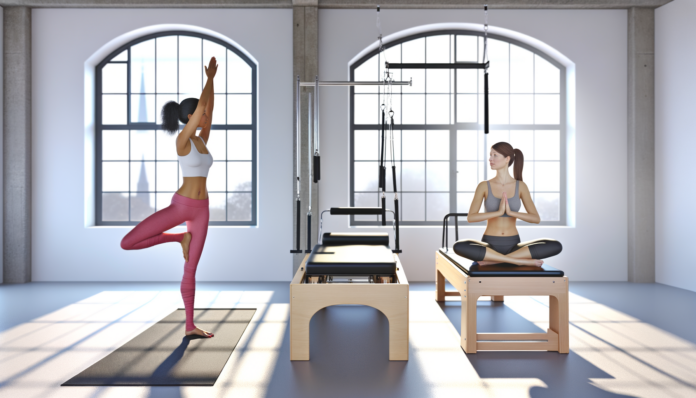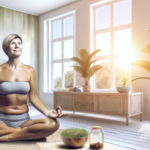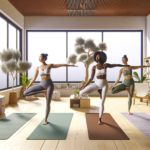Introduction
Overview of Yoga and Pilates
Yoga and Pilates are two distinct practices that have become integral to fitness regimes around the world. While they share similarities such as promoting strength, flexibility, and mind-body awareness, they originate from different historical backgrounds and have unique principles. Yoga is an ancient practice with roots in spiritual traditions of India, focusing on a blend of physical postures, breathing techniques, and meditation. Pilates, on the other hand, was developed in the early 20th century by Joseph Pilates, emphasizing core strength, body control, and muscular endurance. Despite their differences, both are low-impact exercises that can be adapted to various fitness levels and goals.
Importance of Flexibility and Strength in Fitness
Flexibility and strength are foundational elements of a well-rounded fitness routine. Flexibility is crucial for maintaining a range of motion in the joints, reducing the risk of injuries, and improving posture. It also aids in the performance of everyday activities and other forms of exercise. Strength, particularly core strength, is vital for stability, balance, and overall muscular health. It supports the body in all movements and is essential for preventing back pain and other common ailments. Both yoga and Pilates address these aspects, making them beneficial for individuals looking to enhance their physical well-being.
Purpose of the Article
The aim of this article is to delve into the nuances of yoga and Pilates, examining their effectiveness in improving flexibility and strength. We will explore their historical contexts, key principles, and the specific benefits they offer. Additionally, we will provide a comparative analysis to help readers determine which practice might be more suitable for their personal fitness goals. Whether you are a seasoned practitioner or a newcomer to these disciplines, this article seeks to offer valuable insights and guide you towards making an informed choice between yoga and Pilates for your flexibility and strength needs.
Understanding Yoga
Historical Background
Yoga is an ancient practice with its roots deeply planted in the spiritual soil of India. It is believed to have been in existence for over 3,000 years, with origins tracing back to shamanism, Buddhism, and other Eastern philosophies. The practice was refined and codified by sages over the centuries, culminating in a rich tradition that combines physical postures, breathing techniques, and meditation. Yoga’s primary aim is to promote harmony between the mind, body, and spirit, leading to a state of enlightenment or self-realization.
Key Principles and Practices
At the heart of yoga are the five core beliefs: proper relaxation, exercise, breathing, diet, and positive thinking and meditation. These principles guide the practice and are reflected in the various yoga poses (asanas) and breathing exercises (pranayama). Mindfulness and deep breathing are integral to yoga, helping practitioners to focus on the present moment and achieve a state of inner peace. While there are many different styles of yoga, all share the common goal of unifying the body, mind, and spirit.
Benefits for Flexibility
One of the most well-known benefits of yoga is its ability to enhance flexibility. The practice involves a series of poses that stretch and open up the body, particularly targeting the spine, hips, and wrists. Regular yoga practice can lead to greater joint mobility and ease of movement, which is beneficial for people of all ages and fitness levels. Even those with limited flexibility can find a style of yoga that suits their needs, such as restorative or chair yoga, and can benefit from modified poses.
Benefits for Strength
While yoga is often associated with flexibility, it also offers significant strength-building benefits. Many yoga poses require the engagement of various muscle groups, including the core, arms, and legs. Holding these poses over time increases muscle endurance and strength. Additionally, the balance required in many standing and inverted poses helps to build a strong and stable foundation, which is essential for overall physical health and injury prevention.
Yoga’s approach to strength is unique in that it combines physical activity with mindful focus, leading to a holistic strengthening that is as much about mental resilience as it is about physical prowess. This mind-body connection is a cornerstone of yoga, helping practitioners to cultivate inner strength that supports their physical practice.
In conclusion, yoga is a multifaceted practice that offers a wealth of benefits for both flexibility and strength. Its historical roots and key principles emphasize a balanced approach to physical fitness, one that nurtures the body, calms the mind, and uplifts the spirit.
Understanding Pilates
Historical Background
The inception of Pilates dates back to the early 20th century, with its roots firmly planted in the life of its founder, Joseph Pilates. Born in Germany in 1883, Joseph was a frail child who sought to strengthen his body and improve his health. His journey led him to explore various disciplines, including yoga and martial arts, which emphasized the connection between mind and body. His passion for movement and anatomy intensified during World War I when he worked with injured soldiers, developing exercises that enhanced their rehabilitation. After the war, Joseph Pilates migrated to New York City, where his method gained popularity among dancers, actors, and athletes, who appreciated its focus on core strength, flexibility, and mindful movement.
Key Principles and Practices
Pilates is grounded in six core principles: Concentration, Control, Centering, Breath, Flow, and Precision. These principles guide the practice, whether on a mat or using specialized equipment like the reformer. The essence of Pilates is the ‘Powerhouse’ or the core, which includes the muscles of the abdomen, lower back, hips, and buttocks. From this central strength, all movements emanate, ensuring stability and control throughout the exercises.
Benefits for Flexibility
While Pilates is not as widely recognized for its flexibility benefits as yoga, it nonetheless significantly enhances this aspect of fitness. Pilates exercises involve a full range of motion that promotes elongation and stretching of the muscles, leading to increased flexibility, particularly in the core, hips, shoulders, and back. The controlled, deliberate movements encourage a gentle lengthening of the muscles without overextending, making it an excellent choice for maintaining and improving flexibility.
Benefits for Strength
Strength training is a cornerstone of the Pilates method. The practice is particularly effective in building core strength, which is essential for overall stability and balance. Pilates exercises require the engagement of deep core muscles, as well as the coordination of the breath and movement, leading to improved muscle tone and strength throughout the body. Regular Pilates practice can result in a stronger, more sculpted physique, with particular emphasis on the abdominal muscles, lower back, hips, and glutes. Additionally, Pilates can aid in the rehabilitation of injuries, providing a safe way to strengthen weakened areas of the body.
Comparative Analysis
Flexibility in Yoga vs. Pilates
When it comes to enhancing flexibility, both yoga and Pilates offer significant benefits, but they approach it differently. Yoga, with its origins steeped in spiritual practice, emphasizes holding poses and flowing through sequences that can greatly increase the flexibility of the joints, particularly the spine, hips, and wrists. The various styles of yoga, such as Hatha, Vinyasa, and Yin, each focus on stretching and holding poses to varying degrees, which can lead to improved range of motion and elasticity of the muscles.
On the other hand, Pilates, while also improving flexibility, tends to focus more on the strength and stability of the muscles, particularly the core. The exercises in Pilates are designed to stretch the muscles and increase the range of motion around the joints, but with a greater emphasis on maintaining control and precision during the movements. This can lead to a different kind of flexibility, one that is coupled with muscular endurance.
Strength Building in Yoga vs. Pilates
Strength building in yoga is achieved through mastering bodyweight poses and sequences that engage multiple muscle groups simultaneously. The practice of yoga can lead to increased muscle tone, balance, and body awareness. Advanced yoga poses, such as arm balances and inversions, require significant strength and can be particularly effective in building upper body and core strength.
Pilates, conceived as a method of rehabilitation and body conditioning, places a strong emphasis on core strength and stability. The use of specialized equipment like the Reformer adds resistance, making Pilates an effective strength-building workout that targets not just the core but also the arms, legs, and glutes. The precision and control required in Pilates exercises ensure that muscles are worked deeply and efficiently, leading to increased muscular endurance and a more toned physique.
Risk of Injury and Safety Considerations
Both yoga and Pilates are considered low-impact and generally safe forms of exercise, but they are not without risk. In yoga, injuries can occur when practitioners attempt advanced poses without adequate preparation or when they push beyond their flexibility limits. Certain poses may also be contraindicated for individuals with specific health conditions, such as glaucoma or severe osteoporosis.
Pilates exercises, particularly those performed on machines, should be executed with proper form to avoid strain or injury. The risk of injury in Pilates can be higher if practitioners use incorrect technique or fail to engage the core sufficiently. Both practices require guidance from certified instructors to ensure exercises are performed safely and effectively.
Accessibility and Adaptability for Different Fitness Levels
Yoga and Pilates are both highly adaptable, making them accessible to individuals of all fitness levels. Yoga classes often offer modifications for beginners or those with physical limitations, and styles like restorative yoga can be particularly gentle and accommodating. Pilates exercises can also be modified to suit beginners or those recovering from injuries. However, some forms of Pilates, especially those requiring equipment, may be less accessible to those with limited mobility or core strength.
Ultimately, the choice between yoga and Pilates for flexibility and strength may come down to personal preference, fitness goals, and physical condition. Both practices offer unique benefits and can be modified to suit a wide range of abilities, making them valuable additions to any fitness regimen.
Lifestyle Integration
Incorporating Yoga or Pilates into a Busy Schedule
One of the most common barriers to regular exercise is a hectic lifestyle. However, both yoga and Pilates offer flexibility that can accommodate even the busiest of schedules. For those looking to integrate these practices into their lives, consider the following:
- Duration and Frequency: Both yoga and Pilates can be practiced in short sessions. Even 20-30 minutes can be beneficial, and these can be done from the comfort of your home.
- Online Classes: There are numerous online resources available, ranging from free YouTube tutorials to subscription-based services that offer guided sessions at any time.
- Lunch Break Workouts: Utilize breaks in the day for quick sessions. Many workplaces now offer wellness programs that include yoga or Pilates classes.
Cost and Equipment Considerations
When considering the cost, yoga generally requires minimal equipment, often just a mat. Pilates may involve more specialized equipment like reformers, which can be more costly. However, mat-based Pilates is a cost-effective alternative that still offers substantial benefits. Additionally, many exercises in both disciplines can be performed using body weight alone, making them accessible without significant investment.
Community and Support
Both yoga and Pilates have robust communities, both in-person and online. Joining a class can provide motivation and support from instructors and fellow practitioners. For those who prefer a more solitary practice, online forums and social media groups offer a place to share experiences, tips, and encouragement.
In conclusion, integrating yoga or Pilates into one’s lifestyle does not have to be a daunting task. With a bit of planning and the use of available resources, individuals can enjoy the flexibility and strength benefits these practices offer, regardless of their schedule or budget constraints. The key is to start with manageable goals and to be consistent with practice.
Expert Opinions and Studies
Research on Flexibility and Strength Outcomes
When it comes to enhancing flexibility and strength, both yoga and Pilates have been the subject of numerous studies. A study published in the Journal of Strength and Conditioning Research found that Pilates participants experienced improvements in muscular endurance and flexibility. Similarly, yoga has been linked to increased flexibility in various studies. The focus on stretching and holding poses in yoga, which is slightly more emphasized than in Pilates, contributes to this outcome.
Moreover, research has shown that yoga not only aids in physical health but also supports mental well-being, potentially reducing symptoms of anxiety and depression. This is attributed to yoga’s ability to elevate levels of gamma-aminobutyric acid (GABA) in the brain, as reported by Harvard Health Publishing. Pilates, on the other hand, is recognized for its protective physical effects, often involving smaller, controlled movements that minimize the risk of injury.
Professional Recommendations for Women
For women, particularly, both yoga and Pilates offer unique benefits. A systematic review and meta-analysis published in PLoS One suggests that these practices may help maintain bone mineral density in older women, which is crucial for preventing osteoporosis. Additionally, Pilates and yoga are beneficial for strength and balance, which are important for women’s health as they age.
Experts recommend that women choose between yoga and Pilates based on their specific health goals and personal preferences. For those seeking a practice that emphasizes mental relaxation and flexibility, yoga may be the preferred choice. Conversely, women looking for a workout that focuses more on core strength and stability might find Pilates to be more beneficial. Certified instructors emphasize the importance of proper form and technique in both practices to avoid injury and maximize benefits.
Ultimately, the decision between yoga and Pilates should be informed by individual fitness goals, physical limitations, and personal enjoyment. Both practices are adaptable and can be modified to suit different levels of fitness and mobility. Women are encouraged to try both yoga and Pilates to determine which practice resonates more with their body and lifestyle.
Final Thoughts
Both yoga and Pilates have their merits, and the choice between them should be based on personal goals, preferences, and the guidance of health professionals and certified instructors. It’s important to remember that consistency is key to reaping the full benefits of either practice. As such, individuals are encouraged to select the modality that they are most likely to practice regularly and enjoy.
Conclusion
Summary of Findings
Throughout this article, we have explored the intricacies of both yoga and Pilates, delving into their historical backgrounds, key principles, and the unique benefits they offer for flexibility and strength. Yoga, with its ancient roots and holistic approach, offers a wide range of physical and mental benefits, including enhanced muscular strength, improved respiratory and cardiovascular function, and a stronger sense of well-being. Pilates, on the other hand, is a more modern practice with a focus on core strength, flexibility, and alignment, promoting greater proprioception and healthy ranges of motion.
Final Thoughts on Choosing Between Yoga and Pilates
When it comes to deciding between yoga and Pilates, it is clear that neither is superior; both have their merits and can significantly contribute to one’s fitness journey. The choice ultimately hinges on individual goals, preferences, and needs. Pilates may be the go-to for those seeking a structured workout that emphasizes core strength and targets smaller muscle groups, while yoga may appeal more to those looking for a practice that incorporates a meditative or spiritual element and offers a broader range of flexibility benefits.
It is important to recognize that both practices are adaptable and can cater to various fitness levels. They also share commonalities, such as promoting mindful movement and the importance of breathwork, which are integral to achieving the full benefits of each practice. However, they differ in their origins, with yoga offering a philosophical framework that extends beyond physical exercise, and Pilates being primarily a movement-based practice.
Encouragement for Personal Trial and Consistency
Given the unique offerings of yoga and Pilates, we encourage readers to personally trial both practices to discover which resonates more with their body and lifestyle. It is through personal experience and consistency that one can truly gauge the impact of these practices on flexibility, strength, and overall well-being. Whether you choose to integrate one or both into your routine, the key is to maintain a consistent practice and listen to your body’s responses.
Remember, fitness is a personal journey, and what works for one individual may not work for another. Embrace the process of exploration and be open to the possibility that your preferences may evolve over time. By doing so, you can find the perfect balance that supports your health and fitness goals, leading to a more fulfilling and sustainable practice.








